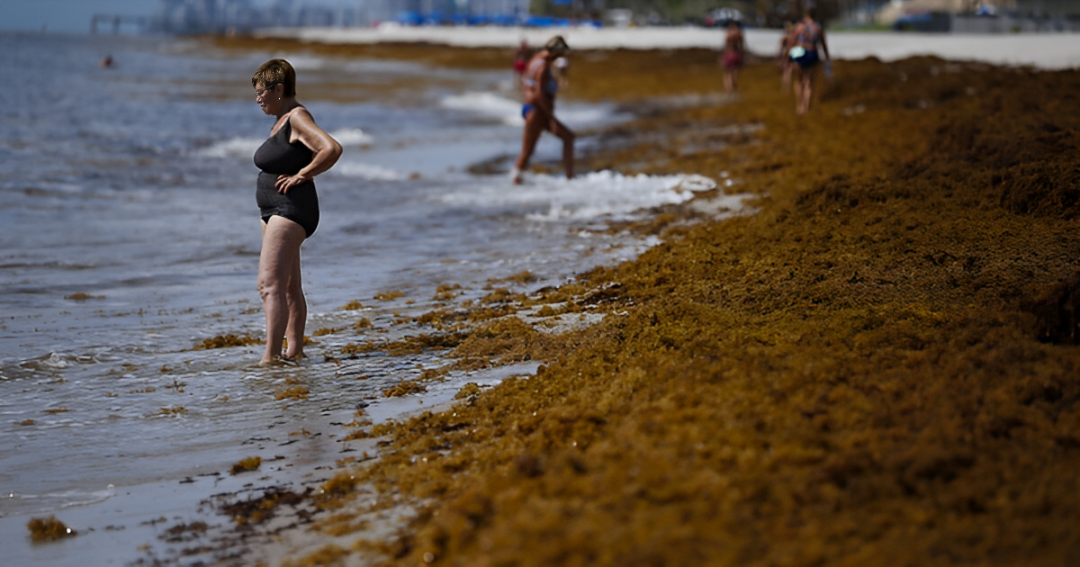South Florida, known for its vibrant beaches, is bracing itself for another potential sargassum season. But what exactly is sargassum, and why is it becoming such a talking point each year?
Sargassum is a type of brown seaweed that floats on the surface of the ocean, often making its way to the shores of South Florida as spring approaches. While the presence of this seaweed may seem harmless at first, large amounts of it washing ashore can lead to environmental and economic issues for local communities.
According to experts, a major sargassum bloom could be headed to Florida this spring. The University of South Florida’s Optical Oceanography Lab has noted “strong signs” that 2025 will be a significant year for sargassum. Brian Barnes, a research associate at the University of South Florida’s College of Marine Science, shared insights about the situation.
What Is Happening in the Ocean?
The amount of sargassum in the central Atlantic Ocean has already reached approximately 4 million tons—a large amount for this time of year. The situation has raised concerns among researchers who study the sargassum blooms. While sargassum in the ocean provides important habitat for marine life, including various fish and invertebrates, an influx of the seaweed onto beaches can cause several issues for Florida residents and tourists.
Barnes explains that when sargassum is far from shore, it serves a valuable role in the ecosystem. However, when it gets carried onto beaches, it can create problems, especially when there are large quantities.
This phenomenon, known as the Great Atlantic Sargassum Belt, stretches from Africa through the Caribbean, often reaching Florida’s shores. While not all of this sargassum will have significant impacts, there’s a chance that large amounts could roll up onto beaches in Florida.
What Does This Mean for Florida?
Sargassum blooms have become an annual occurrence in the Caribbean since 2011, and it appears that 2025 could be no different. The current amount of sargassum in the Atlantic is a strong indicator of a major season. However, Barnes emphasizes that it’s still uncertain whether Florida will face severe sargassum landings. It all depends on the winds and ocean currents that carry the seaweed towards the coast.
Sargassum is typically carried westward by the winds and currents, passing between the Yucatan Peninsula and Cuba, and continuing northward. As it rides the Loop Current, it heads into the Gulf of Mexico, where it can affect the Florida Keys and the Miami area. While sargassum rarely affects the west coast of Florida, the east coast may experience significant impacts, particularly as we head into the summer months.
Timing and Impact on Florida’s Beaches
The first signs of a sargassum influx usually appear around March. However, substantial impacts—such as large amounts of seaweed on beaches—typically don’t occur until May or later. Though it’s too early to make precise predictions, Barnes cautions that if the sargassum arrives, it will likely cause beachgoers and businesses to deal with the effects over the summer months.
One of the biggest concerns for Florida is the economic impact of sargassum. Large amounts of seaweed can crowd beaches, making them less attractive to tourists and more difficult to manage. Removing the seaweed from the beaches is costly, adding to the burden on local governments and businesses.
Is Sargassum Dangerous?
While sargassum itself isn’t directly harmful to humans, it can cause discomfort when it washes ashore. The decaying seaweed emits a strong smell, which can cause respiratory issues for some people. For beachgoers, the presence of sargassum can be more of an inconvenience than a health risk, but it’s still something to keep in mind when planning a beach day.
Looking Ahead: How to Prepare for Sargassum
As the sargassum season looms, Florida residents may start checking sargassum forecasts to get a sense of what to expect. These forecasts are currently based on ocean-wide data, but researchers are working to develop more specific forecasts for individual beaches. With new funding from NOAA, scientists aim to create tools that could give more detailed information about when and where sargassum will impact specific beaches.
In the future, beachgoers might even see new warning flags, similar to the existing red tide flags or surf warning flags. A “sargassum flag” could help people stay informed and avoid unpleasant encounters with seaweed.
Conclusion
Sargassum is more than just seaweed; it’s a seasonal challenge for Florida’s beaches. While it serves as an important part of the ocean ecosystem, large blooms of sargassum can create issues for the environment and local economies. As we head into spring, Florida residents and tourists should be prepared for the possibility of another major sargassum season and stay informed about what it means for their beach plans.
Disclaimer: This article has been meticulously fact-checked by our team to ensure accuracy and uphold transparency. We strive to deliver trustworthy and dependable content to our readers.

